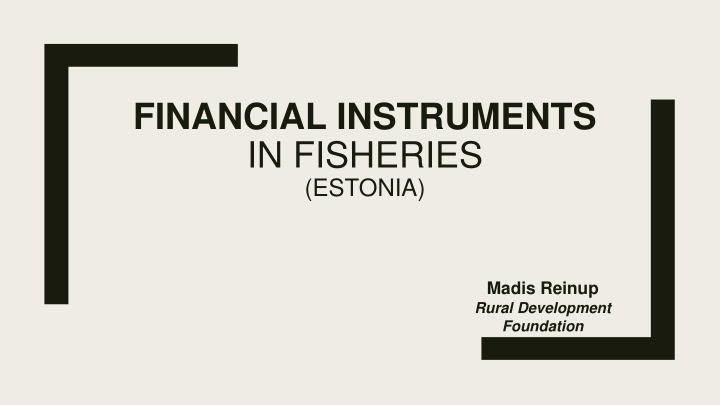



FINANCIAL INSTRUMENTS IN FISHERIES (ESTONIA) Madis Reinup Rural Development Foundation Member of the Board
Rural Development Fund ■ Founded by state in 1993 ■ Equity 38,8 MEUR ■ Financial services for bioeconomy and economy in rural areas : – quarantee portfolio – 73 MEUR, – loan portfolio 10,4MEUR – management of financial instruments: ■ EFF – january 2013 (6MEUR) ■ EAFRD – march 2016 (36MEUR) ■ EMFF – january 2017 (11,2MEUR)
FI ex-ante assesment for EAFRD and EMFF ■ 2014 – Ernst&Young Baltic AS ■ Web questionnaire – 663 enterprises (~15% in fisheries) ■ Detailed interviews -30 ■ 90% - microenterprises
Ex-ante assesment - results ■ No big differences in market gaps for different sectors. ■ Banks are not interested in: – New enterprises – Micro enterprises – Investment loans under 100 000 EUR ■ Long term (7 years +) loans usually not offered. ■ Different views on the value of collateral. ■ Alternative financial market (risk capital etc) missing. ■ NB! Market gap in financial market is a moving target.
• Growth loan (2MEUR) • Investment loan for micro/small enterprises • 10 000 - 100 000 EUR • 7 years (incl. 2 year grace period) • At least 50% collateral. • Interest rates from 2-6%, depending on collateral (may include subsidy) • Long term-investment loan (2MEUR) • Investment loan for micro/small/medium enterprises • 100 000 – 500 000EUR • Co – financing with banks – banks 30%/70% FI • 15 years (incl. 5 year grace period) • At least 80% collateral. • Market based interest rates - still under discussion
• Growth loan (3,2MEUR) • Investment loan for micro/small enterprises • 10 000 - 100 000 EUR • 5 years (incl. 2 year grace period) • At least 50% collateral. • Interest rates from 2-6%, depending on collateral (may include subsidy) • Long term-investment loan (4 MEUR) • Investment loan for micro/small/medium enterprises • 100 000 – 500 000EUR • Co – financing with banks – banks 30%/70% FI • 10 years + 5 year grace period • At least 80% collateral. • Market based interest rates - still under discussion
Lessons learned 1 ■ Investments financed by loans are much more carefully calculated than grants – collateral! ■ In certain cases loan can lead to economically more viable (cheaper) investment decision than grant and a loan (for co-financing) combined; ■ Interest rates are important but ... ■ ... amount of collateral is the key to deal with „access to finance“ problem; ■ Grace period is attractive (for new businesses)! ■ Higher interest rates might „force“ entrepreneurs go to banks (a good thing!) ... .... and ... ■ ... lower interest rate can be tool for policy making – young fishers, investments for adding value etc.
Lessons learned 2 ■ Banks may have sector based (negative) financial policy , so loan applications individually might not be even considered, especially in the time of declining markets; ■ Financial market cap is a moving target, because financial policy of banks might change rapidly – need for flexible FI; ■ Interaction with grants : – FI is for co-financing the grants? – FI are for the ones who will not have grants? – Certain investments (non-productive?) supported by grants and certain (productive?) investments by FI?
Thank you!
Recommend
More recommend